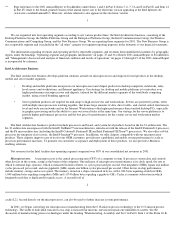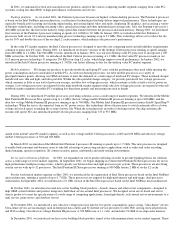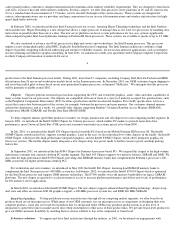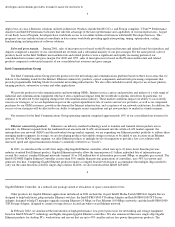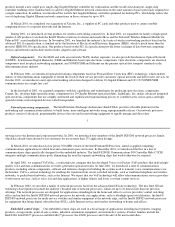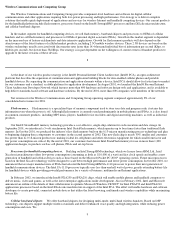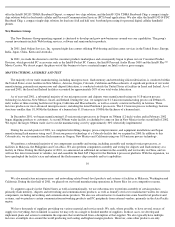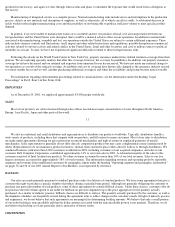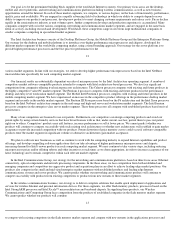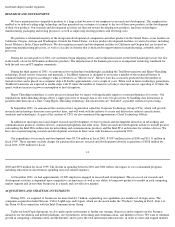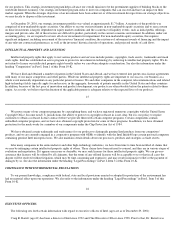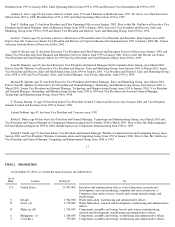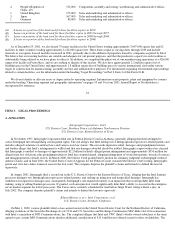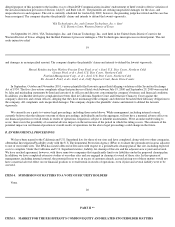Intel 2001 Annual Report Download - page 14
Download and view the complete annual report
Please find page 14 of the 2001 Intel annual report below. You can navigate through the pages in the report by either clicking on the pages listed below, or by using the keyword search tool below to find specific information within the annual report.
for our products. This strategic investment program helps advance our overall mission to be the preeminent supplier of building blocks to the
worldwide Internet economy. Our strategic investment program seeks to invest in companies that can succeed and have an impact on their
market segment. When the strategic objectives of an investment have been achieved, or if the investment diverges from our strategic objectives,
we may decide to dispose of the investment.
At December 29, 2001, our strategic investment portfolio was valued at approximately $1.7 billion. A majority of the portfolio was
comprised of non-marketable equity securities. Our ability to recover our investments in non-marketable equity securities and to earn a return
on these investments is largely dependent on equity market conditions and the occurrence of liquidity events, such as initial public offerings,
mergers and private sales. All of these factors are difficult to predict, particularly in the current economic environment. In addition, under our
accounting policy, we are required to review all of our investments for impairment. For non-marketable equity securities, this requires
significant judgment, including assessment of the investees' financial condition, the existence of subsequent rounds of financing and the impact
of any relevant contractual preferences, as well as the investees' historical results of operations, and projected results of cash flows.
INTELLECTUAL PROPERTY AND LICENSING
Intellectual property rights that apply to our various products and services include patents, copyrights, trade secrets, trademarks and mask
work rights. Intel has established an active program to protect its investment in technology by enforcing its intellectual property rights. We do
not intend to license our intellectual property rights broadly unless we can obtain adequate consideration. See also the information under the
heading "Competition" in Part I, Item 1 of this Form 10-K.
We have filed and obtained a number of patents in the United States and abroad, and we have entered into patent cross-license agreements
with many of our major competitors and other parties. While our intellectual property rights are important to our success, our business as a
whole is not materially dependent on any particular patent or license. We and other companies in the computer, telecommunications and related
high-technology fields typically apply for and receive, in the aggregate, thousands of patents annually in the United States and other countries.
In addition, because of the fast pace of innovation and product development, our products are often obsolete before the patents related to them
expire. As a result, we believe that the duration of the applicable patents is adequate relative to the expected lives of our products.
15
We protect many of our computer programs by copyrighting them, and we have registered numerous copyrights with the United States
Copyright Office. In some non-U.S. jurisdictions, the ability to protect or copyright software in is not clear, but it is our policy to require
customers to obtain a software license contract before we provide them with certain computer programs. Certain components contain
embedded computer programs, and we have also obtained copyright protection for some of these programs. In addition, we have obtained
protection for the mask works for a number of our components under the Chip Protection Act of 1984.
We have obtained certain trademarks and trade names for our products to distinguish genuine Intel products from our competitors'
products, and we are currently engaged in a cooperative program with OEMs to identify with the Intel Inside® logo certain personal computers
containing genuine Intel microprocessors. We also maintain certain details about our processes, products and strategies as trade secrets.
Like many companies in the semiconductor and other high-technology industries, we have from time to time been notified of claims that
we may be infringing certain intellectual property rights of others. These claims have been referred to counsel, and they are in various stages of
evaluation and negotiation. If it appears necessary or desirable, we may seek licenses for these intellectual property rights. We can give no
assurance that licenses will be offered by all claimants, that the terms of any offered licenses will be acceptable to us or that in all cases the
dispute will be resolved without litigation, which may be time consuming and expensive, and may result in injunctive relief or the payment of
damages by us. See also the information under the heading "Legal Proceedings" in Part I, Item 3 of this Form 10-K.
COMPLIANCE WITH ENVIRONMENTAL REGULATIONS
To our present knowledge, compliance with federal, state and local provisions enacted or adopted for protection of the environment has
had no material effect upon our operations. We also refer to the information under the heading "Legal Proceedings" in Part I, Item 3 of this
Form 10-K.
16
EXECUTIVE OFFICERS
The following sets forth certain information with regard to executive officers of Intel (ages are as of December 29, 2001):
Craig R. Barrett (age 62) has been a director of Intel since 1992 and Chief Executive Officer since 1998. Prior to that, Dr. Barrett was


